Fiber Bragg Grating Sensing Principle - FBG Principle - FBG Sensor Principle - FBG Temperature Strain Stress Vibration Shape Sensing Principle
This article explains the principle of Fiber Bragg Grating (FBG) sensors based on the fundamental concept of "reflection and interference of light waves," including the principles of temperature measurement, stress measurement, and strain measurement using FBGs. It then introduces the working principle of FBG sensors and provides a schematic diagram of the FBG sensor's principle.
The article further discusses the accurate temperature measurement principle of FBG temperature sensors and introduces the principle of using accurate FBG thermometers to compensate for the temperature of FBG stress sensors. This compensation principle is also applicable to FBG strain sensors, FBG shape sensors, and other FBG sensors.
Finally, the article explains the differences between Fiber Bragg Grating sensing technology and distributed fiber sensing technology in terms of principles.
Table of Contents:
Ⅳ. Fiber Bragg Grating Sensor Principle Video, Fiber Bragg Grating Principle Video.
Ⅶ. Why is Temperature Compensation Necessary for Fiber Bragg Grating Strain Sensors? The Principle of Temperature Compensation (FBG Strain Gauge) for Accurate Measurement.
The article provides comprehensive explanations of the principles. It is recommended to focus on the sections of interest for better understanding.
Ⅰ. Principle of Reflection and Interference of Light Waves - Analogy between Sound Waves' Reflection and Superposition and Light Waves' Reflection and Superposition.
1. Why is it necessary to understand the principle of reflection and interference of light waves before understanding the basic principles of Fiber Bragg Grating (FBG) and Fiber Bragg Grating sensors (FBG sensors)?
Before delving into the basic principles of Fiber Bragg Grating (FBG) and Fiber Bragg Grating sensors (FBG sensors), it is essential to grasp the concepts of reflection and interference of light waves.
This is because the most crucial part of a Fiber Bragg Grating sensor (FBG sensor) lies in accurately detecting certain specific wavelengths of reflected waves. By analyzing the wavelength changes in the reflected waves, the sensor can measure the variations of the physical quantity being monitored, such as stress, strain, or temperature.
Since light waves have high frequencies and short wavelengths, they are not easily observed directly in our daily lives. To facilitate understanding, I will use sound waves as an analogy to light waves—both are waves, even though one is audible, and the other is not.
2. Echoes of sound waves, showing the principle of reflection and interference, apply the same characteristics to light waves.
In daily life, you may have experienced the following situation: when you shout facing two walls or two mountains, you hear two or more echoes (reflection of sound waves); if you adjust your position and continue shouting, you will hear the echoes combine into a single echo at specific positions (satisfying certain conditions), and as you move, the echoes may vary in intensity.
The loud echo is a result of positive interference (interference of sound waves) from multiple reflections, while the softer echo is caused by negative interference (interference of sound waves) from multiple reflections.
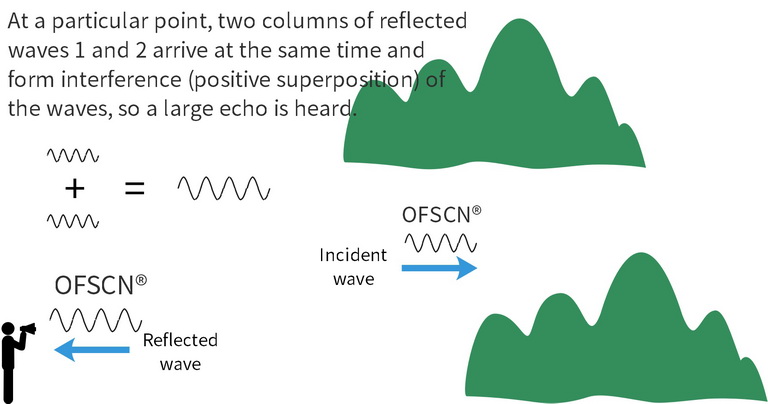 |
|
Image 1 |
Similarly, light waves, like sound waves, also exhibit these properties on a smaller scale. When certain conditions (Bragg conditions) are met, light waves passing through a Fiber Bragg Grating (FBG) will experience multiple reflections, leading to positive interference (interference) of reflected waves.
3. Further reading:
One of the basic principles of Fiber Bragg Grating (FBG) and Fiber Bragg Grating sensors (FBG sensors): Reflection and interference of waves.
Basic principles of Fiber Bragg Grating (FBG) and Fiber Bragg Grating sensors (FBG sensors) Ⅰ : Reflection and interference of waves.
Ⅱ. What are Fiber Bragg Gratings? What can Fiber Bragg Gratings do? The Principle of Fiber Bragg Gratings (FBG Fiber Bragg Grating Principle).
Fiber Bragg Grating (FBG) is a type of optical fiber grating with a uniform and consistent grating period (fiber periodicity). The distance between the reflection points of the FBG is always equal. FBGs can be produced through various methods, such as exposure to ultraviolet light using a mask, chemical etching, or femtosecond laser point-by-point writing, etc. They can be single-point FBGs or FBG strings/arrays (FBG arrays).
 |
|
Image 2 |
By connecting a Fiber Bragg Grating sensor to a FBG demodulator, one can measure the wavelength of the independent reflected waves. When the Fiber Bragg Grating (FBG) experiences changes in stress or temperature, the grating period (grating periodicity) will change, leading to variations in the wavelength of the reflected waves. Different wavelengths will be reflected, allowing the measurement of the change in Bragg wavelength.
The change in Bragg wavelength (ΔλB) of Fiber Bragg Grating (FBG) is related to both the strain (Δε) and the temperature change (ΔT), and the formula is as follows: ΔλB = λB(1 - Pe)Δε + λB(αf - ξ)ΔT.
1. Principle of Fiber Bragg Grating (FBG) for Temperature Sensing—FBG Temperature Sensor Principle (FBG Thermometer)—Length Change due to Thermal Expansion and Contraction
In the environment where the Fiber Bragg Grating (FBG) is located, changes in temperature will cause regular variations in the grating period Λ (fiber periodicity) of the FBG. In simple terms, it's thermal expansion and contraction.
 |
| Image 3 |
By using a Fiber Bragg Grating demodulator, the reflected wavelength λB of the FBG can be measured. Since the reflected wavelength λB and the grating period Λ of the Fiber Bragg Grating have a corresponding relationship (λB = 2neffΛ, where neff is the fiber refractive index), the temperature of the Fiber Bragg Grating can be determined by understanding the reflected wavelength. This is the principle of temperature sensing using FBGs.
2. Principle of Fiber Bragg Grating (FBG) for Stress Sensing—FBG Strain Gauge Principle (FBG Load Cell, FBG Pressure Sensor)—Length Change due to Force
Similar to temperature changes, variations in force will also cause regular changes in the grating period Λ (fiber periodicity) of the Fiber Bragg Grating (FBG). In simple terms, it's stretching or compressing.
 |
| Image 4 |
By using a Fiber Bragg Grating demodulator, the reflected wavelength λB of the FBG can be measured. Since the reflected wavelength λB and the grating period Λ of the Fiber Bragg Grating have a corresponding relationship (λB = 2neffΛ, where neff is the fiber refractive index), the force applied to the Fiber Bragg Grating (FBG) can be determined by understanding the reflected wavelength. This is how FBGs can be used to measure stress.
3. Principle of Fiber Bragg Grating (FBG) for Strain Sensing—FBG Strain Sensor (FBG Strain Gauge)—Length Change Itself
Whether it is the variation in Fiber Bragg Grating due to temperature or force, the ultimate manifestation is the change in the length of the Fiber Bragg Grating (strain). In the formula λB = 2neffΛ, Λ represents the grating period (fiber periodicity) of the Fiber Bragg Grating itself, which is the length of the Fiber Bragg Grating at a small scale. Therefore, Fiber Bragg Gratings can be used to measure strain.
 |
| 图5 |
4. Further reading:
Ⅲ. What is a Fiber Bragg Grating Sensor? Why do we need to encapsulate Fiber Bragg Gratings? The Working Principle of Fiber Bragg Grating Snsors.
Although Fiber Bragg Grating (FBG) can be used to measure temperature, stress, and strain, it must be encapsulated into a Fiber Bragg Grating sensor (FBG sensor) before it can be used due to its inherent fragility.
 |
| Image 6 |
DCYS creatively combines stainless steel seamless tubes with Fiber Bragg Gratings (FBG) to produce patented OFSCN® capillary series seamless steel tube Fiber Bragg Grating sensors, including seamless steel tube Fiber Bragg Grating temperature sensors (FBG thermometers), seamless steel tube Fiber Bragg Grating stress sensors (FBG load cells, FBG pressure sensors), and seamless steel tube Fiber Bragg Grating strain sensors (FBG strain gauges).
The protection provided by the stainless steel seamless tube significantly enhances the strength of the Fiber Bragg Grating and the fiber, expanding the range of environments and applications for various Fiber Bragg Grating sensors.
The working principle of the OFSCN® capillary series seamless steel tube Fiber Bragg Grating sensors is similar to the principle of FBG.
1. Principle Diagram of Fiber Bragg Grating (FBG) and Fiber Bragg Grating Sensor (FBG Sensor)
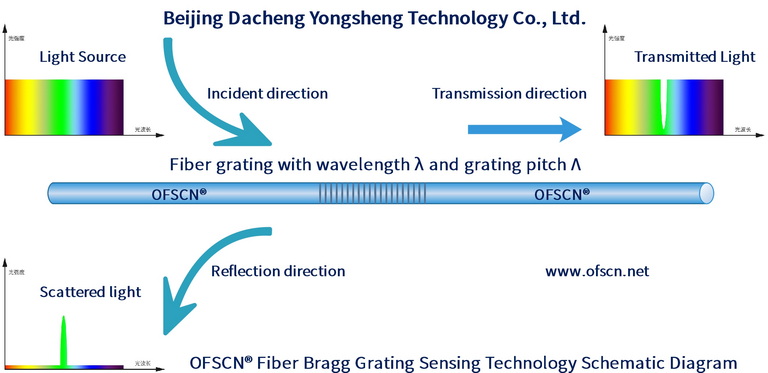 |
|
Image 7 |
2. Formula of Fiber Bragg Grating (FBG) Principle and Fiber Bragg Grating Sensor (FBG Sensor) Principle
In Image 3, the middle part represents a Fiber Bragg Grating (FBG) or an encapsulated OFSCN® capillary series seamless steel tube Fiber Bragg Grating sensor (FBG sensor). Broadband incident light enters the fiber from one end of the sensor, and when it encounters the Fiber Bragg Grating (FBG), most of the light with various wavelengths passes through the FBG as transmitted light, while a small portion of special wavelengths of light is reflected back (note that this special wavelength, represented by λB, is the parameter we want to measure).
There is a direct relationship between λB and the grating period Λ, represented by the mathematical expression: λB = 2neffΛ, where λ is the reflected wavelength, neff is the effective refractive index of the fiber core, and Λ is the grating period.
Next, the reflected light enters the Fiber Bragg Grating demodulator (not labeled in the image) and is demodulated into the wavelength signal λB. Since the sensor is connected to the measurement equipment, we can obtain different test wavelength signals λB at different times.
Through the previous mathematical expression, we can understand why the wavelength signal λ changes in the next moment (change represented by ΔλB)? The fundamental reason is that the grating period Λ of the Fiber Bragg Grating has changed (change represented by ΔΛ).
3. Principles of How Fiber Bragg Grating (FBG) and Fiber Bragg Grating Sensor (FBG Sensor) Measure Temperature, Strain, and Stress
Now, we can step out of the complex mathematical symbols and switch back to the real-world environment. What can cause the grating period Λ (grating periodicity) of the FBG to change?
You might immediately think of two possibilities:
① Force: When you apply tension to the Fiber Bragg Grating (FBG), it elongates; when you apply compression, it contracts.
② Temperature: When the Fiber Bragg Grating (FBG) is heated, it expands; when it cools down, it contracts.
In this process, smart people have connected the wavelength signal that can be accurately detected with three fundamental physical parameters: force (tension, compression), length (elongation, contraction), and temperature (heating, cooling). Therefore, Fiber Bragg Grating sensors (FBG sensors) can directly measure stress, strain, and temperature.
Specific products correspond to OFSCN® capillary seamless steel tube Fiber Bragg Grating stress sensors, OFSCN® capillary seamless steel tube Fiber Bragg Grating strain sensors, and OFSCN® capillary seamless steel tube Fiber Bragg Grating temperature sensors.
4. Further reading:
Basic Principles of Fiber Bragg Grating Sensors Part 2- Fiber Bragg Grating Sensing Principles
Ⅳ. Fiber Bragg Grating Sensor Principle Video, Fiber Bragg Grating Principle Video:
Ⅴ. Are Fiber Bragg Grating Temperature Sensors Accurate in Temperature Measurement? The Principle of Accurate Temperature Measurement by Fiber Bragg Grating Temperature Sensors (FBG Thermometer).
1. Analysis of the Principle of Accurate Temperature Measurement for Fiber Bragg Grating Temperature Sensor (FBG Thermometer)
Since both temperature and force can cause changes in the wavelength of the Fiber Bragg Grating, in order for the Fiber Bragg Grating Temperature Sensor (FBG Thermometer) to accurately measure temperature, it must be designed in a way that only temperature variations affect the encapsulated Fiber Bragg Grating Temperature Sensor (FBG Thermometer), and the influence of tension and pressure variations is minimized.
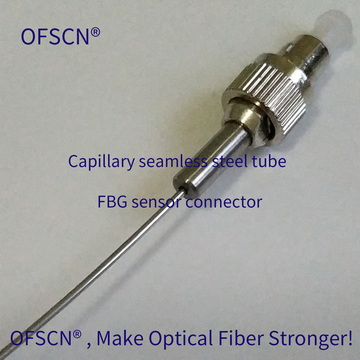 |
 |
| Image 8 | Image 9 |
DCYS's OFSCN® capillary series seamless steel tube Fiber Bragg Grating Temperature Sensor (FBG Thermometer) uses patented encapsulation technology, ensuring that the Fiber Bragg Grating (FBG) remains in a free state during temperature measurements, not influenced by external forces, and thus achieving accurate temperature measurements.
2. Further reading:
3. Analysis of the Principle of Inaccurate Temperature Measurement for Traditional Fiber Bragg Grating Temperature Sensor (FBG Thermometer)
The main reason for the inaccurate temperature measurement of traditional Fiber Bragg Grating Temperature Sensors (FBG Thermometers) is that it is challenging to shield the effects of forces while measuring temperature. This is due to the encapsulation method used.
 |
|
Image 10 |
In traditional Fiber Bragg Grating Temperature Sensors (FBG Thermometers), the use of various materials and adhesives makes it difficult to shield the FBG from the influence of forces.
4. Further reading:
Drawbacks and Force Analysis of Traditional Fiber Bragg Grating Temperature Sensors (FBG Thermometers) - Reasons for Inaccurate Temperature Measurement
Drawbacks and Force Analysis of Traditional Fiber Bragg Grating Temperature Sensors (FBG Thermometers) - Reasons for Inaccurate Temperature Measurement
Ⅵ. Why is Temperature Compensation Necessary for Fiber Bragg Grating Stress Sensors? The Principle of Temperature Compensation (FBG Load Cell, FBG Pressure Sensor) for Accurate Measurement.
Fiber Bragg Grating (FBG) is sensitive to both force and temperature. Whether the Fiber Bragg Grating is under force or the enviroment temperature changes, it reflects as changes in the grating period, which corresponds to the occurrence of strain in the Fiber Bragg Grating sensor.
1. Principle of Temperature Compensation for Fiber Bragg Grating Stress Sensors
This means that when you want to use a Fiber Bragg Grating Stress Sensor to achieve accurate measurements, you must consider whether the ambient temperature has changed. You need to eliminate the influence of temperature on the reflected wavelength from the formula ΔλB = λB(1 - Pe)Δε + λB(αf - ξ). In other words, you need to keep ΔT = 0 (maintain a constant ambient temperature) or know the value of ΔT (know the extent of ambient temperature change). This process is called temperature compensation for Fiber Bragg Grating Stress Sensors.
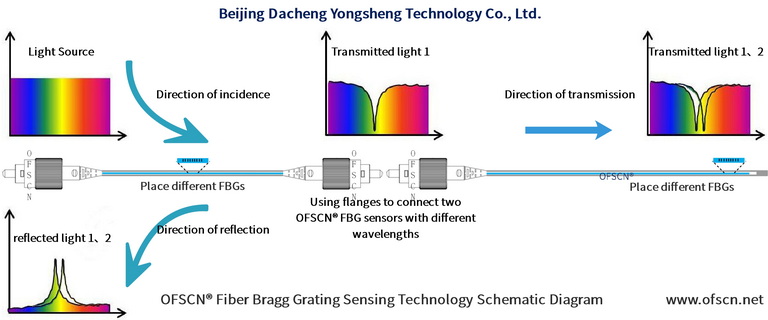 |
|
Image 11 |
Since we already have a Fiber Bragg Grating Temperature Sensor (FBG Thermometer) produced by DCYS that can accurately measure temperature, we can place this accurate temperature-measuring Fiber Bragg Grating Temperature Sensor (FBG Thermometer) and the Fiber Bragg Grating Stress Sensor (FBG Load Cell, FBG Pressure Sensor) in the same environment to determine the exact value of ΔT.
Consequently, we can use the formula ΔλB = λB(1 - Pe)Δε + λB(αf - ξ) to eliminate the influence of temperature changes, enabling the Fiber Bragg Grating Stress Sensor (FBG Load Cell, FBG Pressure Sensor) to accurately measure tension and pressure.
2. Further reading:
Principle and Scheme of Temperature Compensation for Fiber Bragg Grating Stress Sensors
Ⅶ. Why is Temperature Compensation Necessary for Fiber Bragg Grating Strain Sensors? The Principle of Temperature Compensation (FBG Strain Gauge) for Accurate Measurement.
The principle of temperature compensation for FBG Stress Sensors also applies to other types of Fiber Bragg Grating sensors, such as FBG Shape Sensors, FBG Gas Sensors, FBG Inclination Sensors, FBG Pressure Sensors, etc.
Ⅷ. Differences and Connections between Fiber Bragg Grating Sensors, Distributed Fiber Sensors, and the Principle Differences from Distributed Fiber Sensing Technology.
Fiber Bragg Grating sensing technology and Optical Fiber sensing technology are inclusive concepts, just as "Fiber Bragg Grating sensors and Optical Fiber sensors are inclusive concepts."
Fiber Bragg Grating sensing technology is a type of Optical Fiber sensing technology, and Fiber Bragg Grating sensors are a type of Optical Fiber sensors. The basic principles of Fiber Bragg Grating sensing technology have been discussed in this text and will not be repeated here.
1. Principle and Diagram of Distributed Fiber Optic Sensing Technology
Distributed Optical Fiber sensors and Fiber Bragg Grating sensors belong to the same category of Optical Fiber sensors. However, unlike Fiber Bragg Grating sensors, common Distributed Optical Fiber sensing technology is based on various scattering intensity, frequency, and phase information within the fiber and uses the fiber as the sensing unit.
The physical quantities measured not only depend on the fiber but also rely more on modulation-demodulation devices and algorithms. The measured physical quantities are often the average values of physical quantities at specific positions along the fiber (e.g., the average temperature over every 1 meter on a 10-kilometer fiber). The sensing principle can be understood from the diagram below:
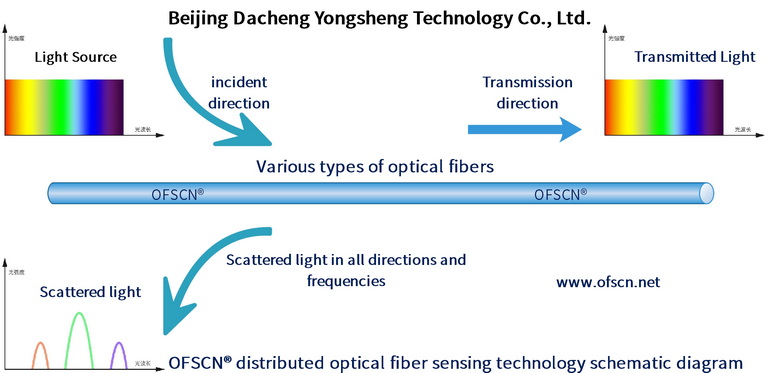 |
|
Image 13 |
Similarly, broadband light emitted from the Optical Fiber sensing device enters the fiber from left to right, and due to the inherent impurities in the fiber, light scatters during propagation.
You can think of the light particles colliding with the impurities in the fiber, resulting in particles scattering in various directions, with different frequencies. These scattered light signals are collectively referred to as scattered light, and there are three types: Rayleigh scattering, Raman scattering, and Brillouin scattering, based on different frequency characteristics.
These scattered light signals are typically related to the position, temperature, stress, strain, vibration, and other physical quantities of the environment where the fiber is located. Therefore, various devices have been developed to measure these physical quantities by measuring changes in the scattered light signals within the fiber.
2. Further reading:
3. Video on the Principle Difference between Fiber Bragg Grating Sensing Technology and Distributed Optical Fiber Sensing Technology:
